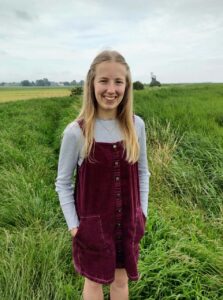

Rose McNelly
PhD MECEA Winner 2024
My adventures with Aegilops tauschii to understand starch granule formation
- PhD MECEA Winner 2024
- | Part of MECEA
Growing up in Norfolk, I’ve always been exposed to plants; you can’t drive very far without seeing fields of wheat, barley and sugar beet growing. Perhaps it was no surprise that I ended up specialising in plant science at university. However, my course only whetted my appetite for plant science and left me with many questions, like how can we improve plants to meet the needs of the growing population? This is the type of question which motivates me in my daily work.
After my undergraduate degree, I started a Ph.D. at the John Innes Centre, as part of the John Innes Foundation Rotation Ph.D. programme. My rotations exposed me to the wonders of cereal research, however it was my final Ph.D. project, which is a collaboration between David Seung’s and Cristobal Uauy’s lab, where my passion came to fruition. During my project I have been unravelling the complexities of what controls starch granule size and number in the Triticeae, with the goal that this knowledge could be useful for breeders and farmers to improve grain quality.
In wheat grains, there are two classes of starch granules – large lenticular A-type and small spherical B-type. The size distribution and composition of starch granules has strong influence on grain quality and the end uses of starch, but the genetic control of these traits remains poorly understood. Work from the 1990s suggested that Ae. tauschii has variation in these traits, but this had not been explored further [1, 2]. In my project, I characterised endosperm starch in a diversity panel of 117 Ae. tauschii accessions. Excitingly, I discovered enormous variation in granule size distribution among the accessions, so I utilised this in a genome wide association study. This uncovered the starch debranching enzyme LIMIT DEXTRINASE (LDA) as a major candidate gene associated with B-type granule size, and an additional 5 QTLs affecting granule size or number. The role of LDA in the wheat endosperm has not been investigated, so I am using barley RNAi lines and wheat TILLING mutants to decipher its role in granule formation and expand our mechanistic model of granule initiation.
I believe that my discoveries could have a lasting impact on the cereal community. The potential applications of LDA are enormous. It may be used to control B-type granule size in barley, which could be valuable to brewing as small B-type granules gives beer an unwanted cloudy appearance. Starch granule size has a major impact on the digestive properties of starch, so my findings have implications on nutrition and human health. Beyond LDA, the additional QTLs could be incorporated into breeding pipelines which could have beneficial impacts on grain quality.
To supplement my GWAS, I have generated biparental mapping populations in Ae. tauschii. When I initially proposed this idea, I was heavily discouraged and was told that crossing Ae. tauschii was extremely difficult. Thankfully, I ignored the advice and I now have 22 mapping populations, which are a useful resource for many different groups at the John Innes Centre.
Through producing these mapping populations, I discovered that one of the most satisfying aspects of science is producing something which is not only useful for yourself but can also transform the work of others. I am therefore determined to produce and share resources to enhance the work of the cereal community. One such resource is a Python script I developed to analyse starch granule size distributions. Though this was initially a challenge, as I had no prior Python experience, I was able to collaborate with mathematical biologists to produce a script which uses a novel combination of mathematical models to determine starch granule size and content in a quick and easy manner. This has been heavily used by the members of my lab [3] and external collaborators in the UK and beyond.
Perhaps the most important thing I’ve learnt during my academic journey thus far is the importance of communicating research to those within, and beyond, the scientific community. Whether it’s presenting at conferences, producing material for the Plantae community as an ASPB fellow, taking over the Monogram twitter account, or volunteering at schools as a STEM ambassador, I believe these are essential as science isn’t finished until it’s been effectively communicated. In fact, one of the best moments of my Ph.D. has been leading the John Innes Centre display at the 2022 Norfolk Show. Seeing the amazement on the faces of school children as they looked at starch granules down a microscope and knowing that this moment could set them on a path to study plant science in the future is heart-warming. Some might say I haven’t come far since my early days, as I am still amazed every time I pass a field of wheat. However, that amazement is now accompanied by an excitement that my research has the potential to improve the plants I am seeing.
References:
[1] Stoddard. (1999) Cereal Chemistry 76, 145-149. [2] Stoddard et al. (2000) Cereal Chemistry 77, 445-447. [3] Esch et al. (2023) New Phytol. 240, 224-241.
